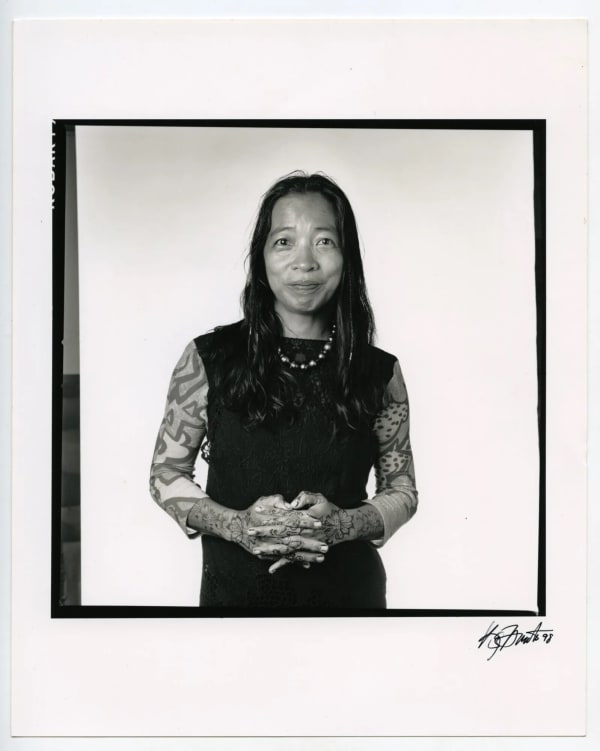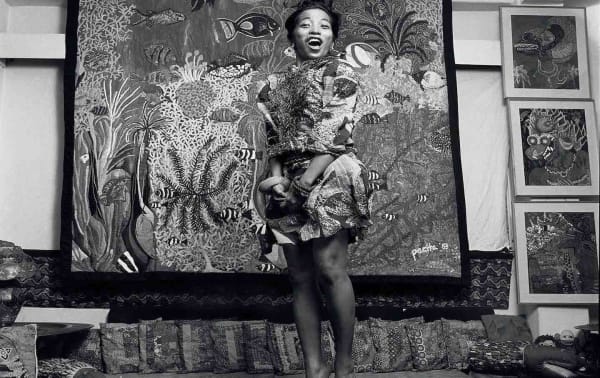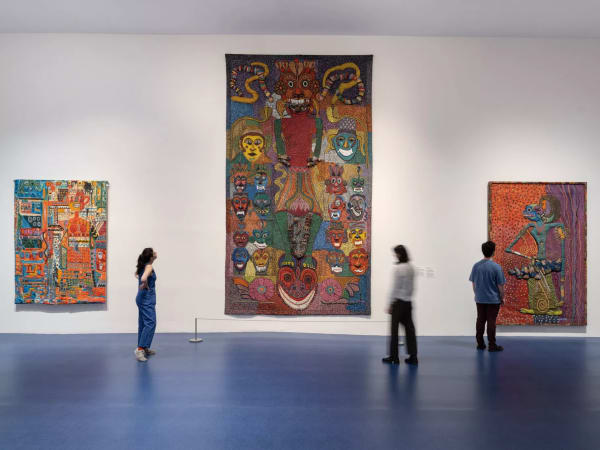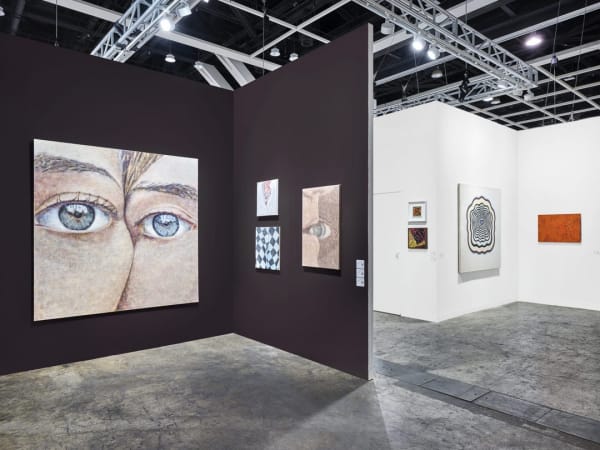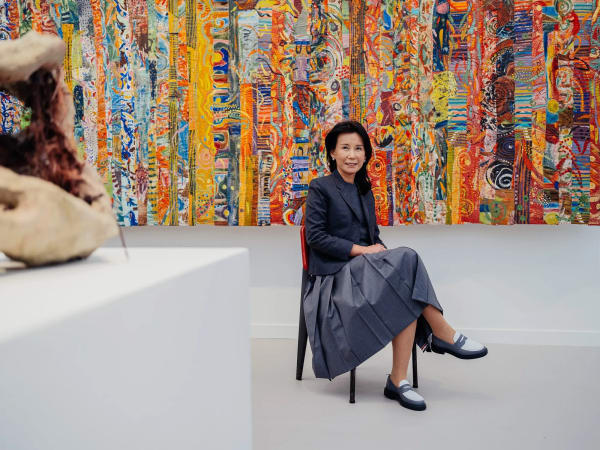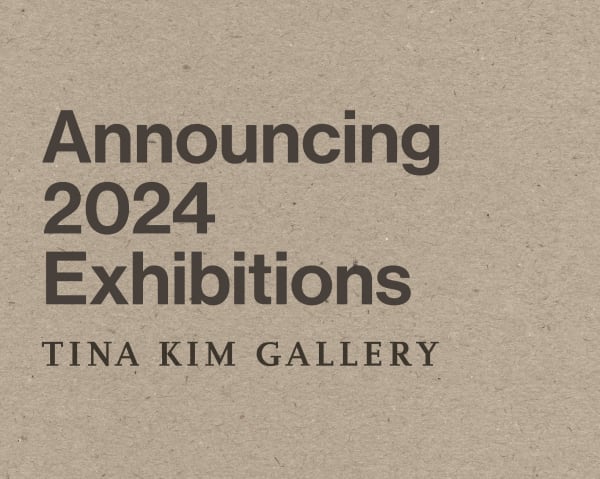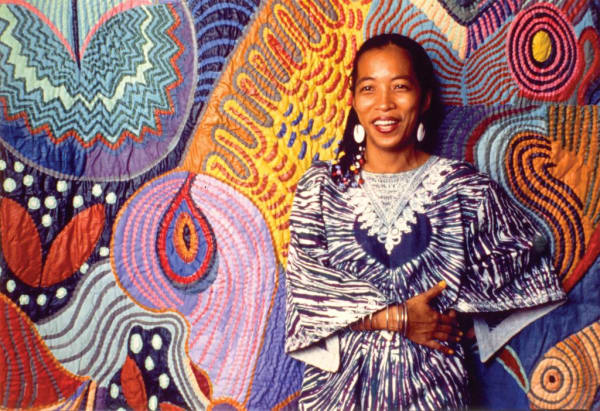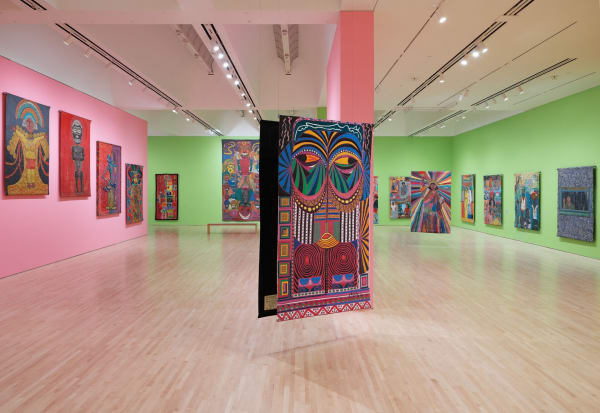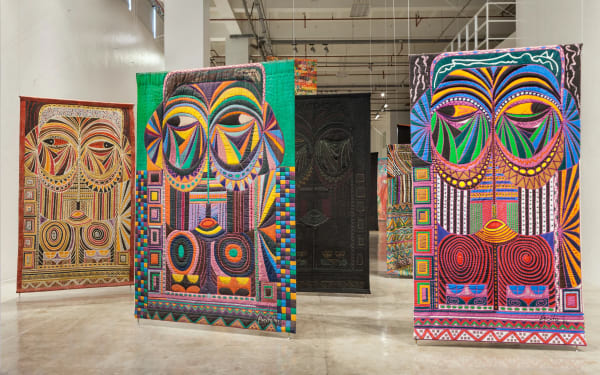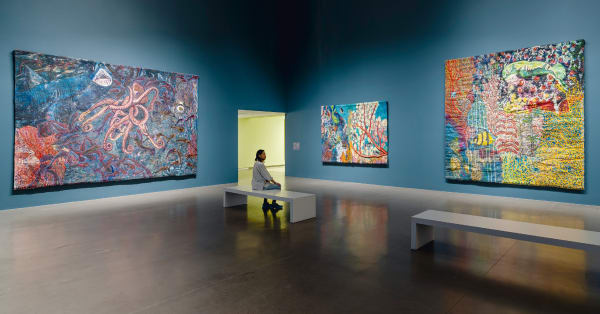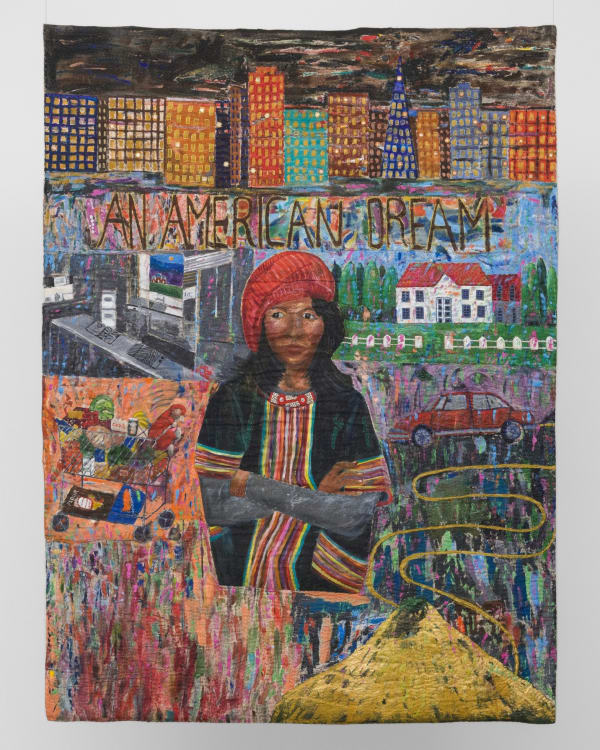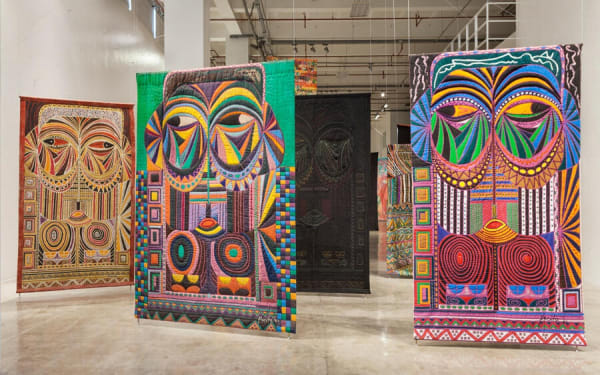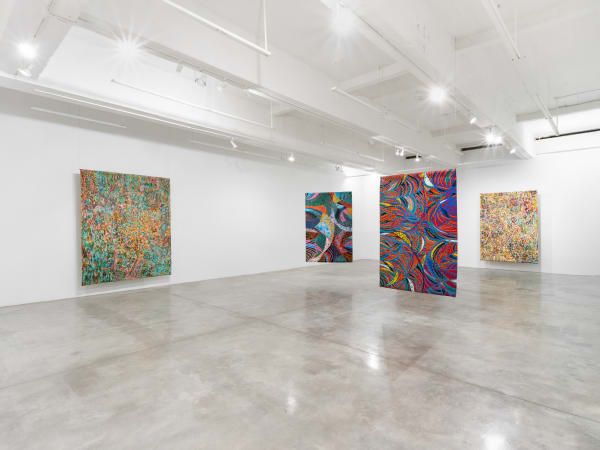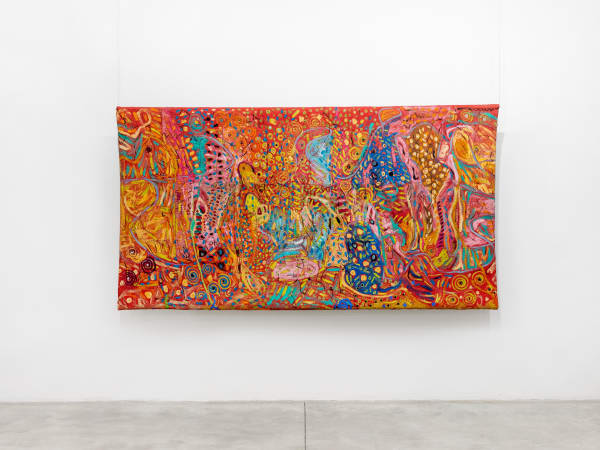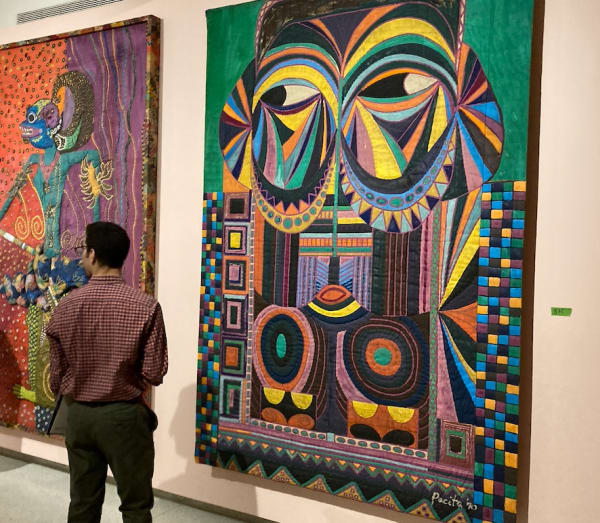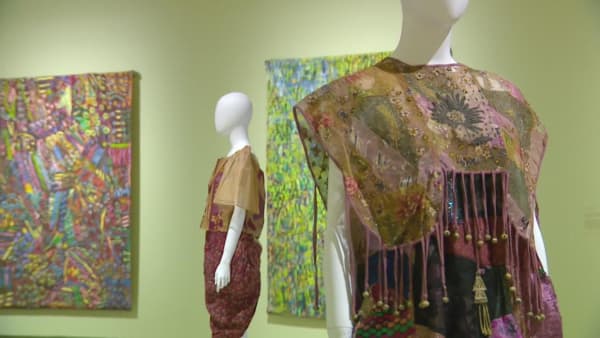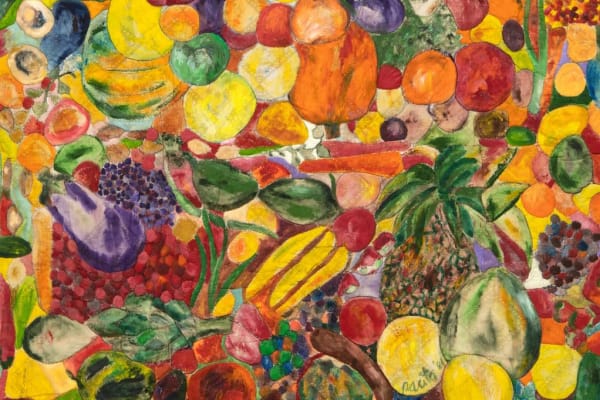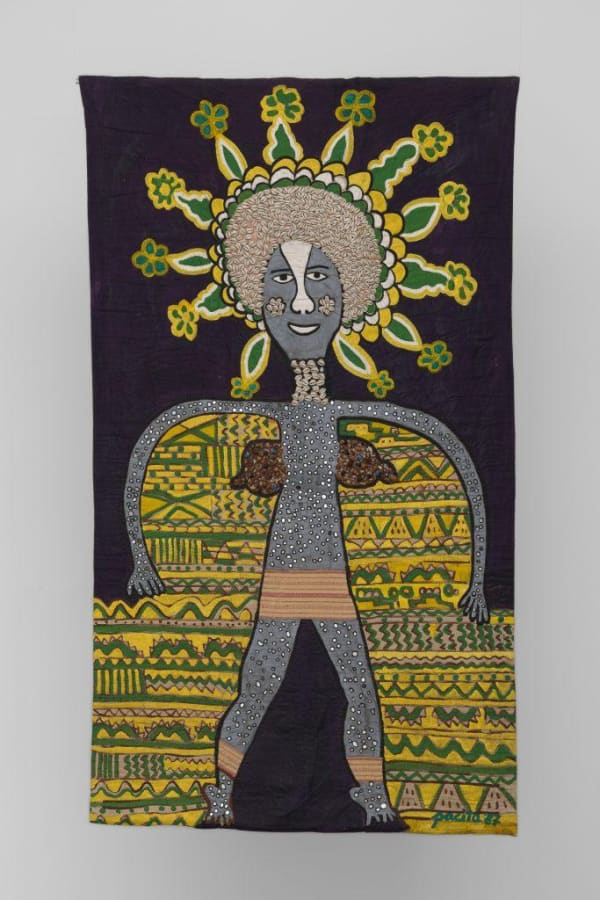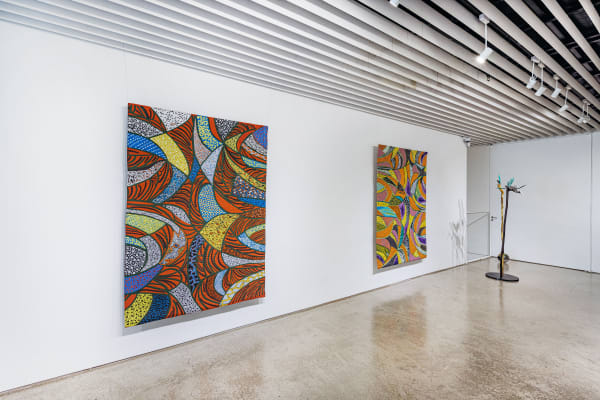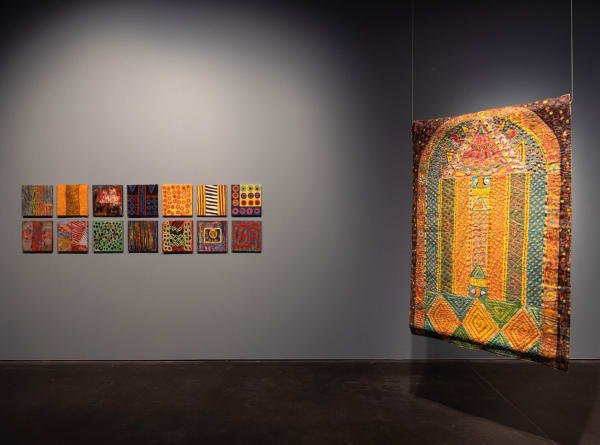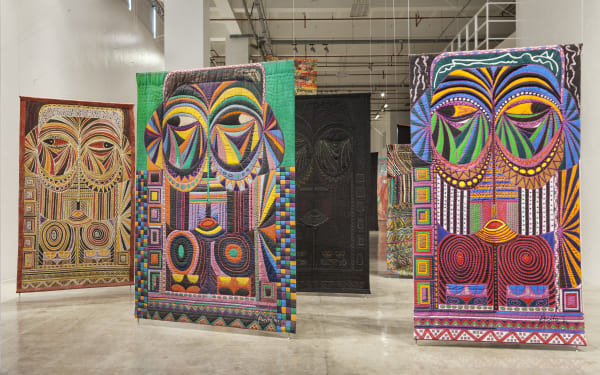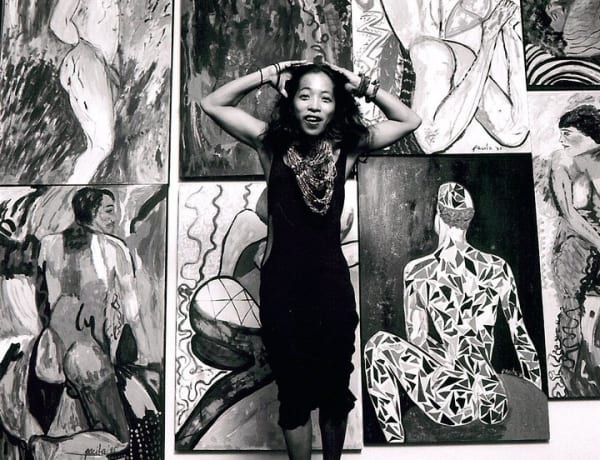Born to a family of politicians and activists in Batanes, the furthermost-north island state in the Philippines, Pacita Abad (1946-2004) was sent to the US to finish her graduate studies after political violence initiated by Ferdinand Marcos put her life in danger. Abad settled in San Francisco in 1970, drawn in by the Summer of Love, and met Jack Garrity a few years later, the two embarking upon a yearlong odyssey across Asia in 1973. While this trip and its myriad multicultural interactions convinced Abad to devote herself to art, it also foreshadowed the itinerant, global lifestyle that would characterize her artistic practice.
Widely defined by her use of color, something she remained adamant about from her early studies, Abad pioneered new forms of materiality in her work, illustrated in one instance by her widely celebrated trapunto paintings, a form of quilted painting the artist originated by stitching and stuffing her painted canvases instead of stretching them over a frame. Her oeuvre featured an immense array of subject matter, from tribal masks and social realist tableaus to lush and intricately rendered underwater scenes and abstractions. Accumulating materials, techniques, and subjects from her vast travels, oftentimes within the same composition, Abad was uniquely positioned to explore modernity's uneven development with the greatest care, as a figure born outside of the metropole. Her work predates contemporary discourses around postcolonial feminisms, globalization and transnationalism, offering an intuitive understanding of the mutability and heritability of traditions in the places she lived.
Her work has been featured at notable exhibitions, including the 11th Berlin Biennale; 13th Gwangju Biennale; 4th Kathmandu Triennale; Asia/America: Identities in Contemporary Asian American Art, a travelling exhibition organized by the Asia Society, New York; Beyond the Border: Art by Recent Immigrants, Bronx Museum of the Arts, New York; La Segunda Bienal de la Habana, Cuba; and Second Contemporary Asian Art Show, Fukuoka Art Museum, Japan. She has also participated in group exhibitions at institutions including: Haus Der Kunst, Germany; Tate Liverpool; Para Site, Hong Kong; and the National Gallery, Singapore. Her work can be found in the collections of Tate Modern, London; The National Museum of Women in the Arts, Washington D.C., M+ Museum, Hong Kong and the National Gallery of Singapore. She died in Singapore in 2004.
-

Pacita Abad
MoMA PS1 4 Apr - 2 Sep 2024The first retrospective of artist Pacita Abad (b. Philippines, 1946–2004) will unfold across MoMA PS1’s third-floor galleries. Spanning the artist’s 32-year career, the exhibition includes more than 50 works—most of...Learn More -

Pacita Abad
SFMOMA 21 Oct 2023 - 28 Jan 2024Pacita Abad opens at The San Francisco Museum of Modern Art (SFMOMA) today, marking the second destination of the major North American retrospective of the influential Filipino-American artist. Featuring more...Learn More -

Pacita Abad
Colors of My Dream 18 May - 24 Jun 2023Learn More -

Walker Art Center
Pacita Abad 15 Apr 2023We are pleased to announce Pacita Abad, the first retrospective of the artist, opening at the Walker Art Center on April 15th. Featuring significant and rarely-seen works from across Abad’s...Learn More -

Is it morning for you yet? | The 58th Carnegie International
Pacita Abad 24 Sep 2022Is it morning for you yet?, the 58th Carnegie International, featuring Pacita Abad, is on view at Carnegie Museum of Art from September 24, 2022 through April 2, 2023. Organized...Learn More -

The Cumulative Effect
A group show featuring Andrew Kreps, Bortolami, and Tina Kim Gallery curated by John Yau 30 Aug - 15 Sep 2022Learn More -

Jameel Arts Centre
Pacita Abad: I Thought The Streets Were Paved With Gold 8 Sep 2021 - 13 Feb 2022Known for her large scale, colorful ‘trapunto’ works, Pacita Abad (1946-2004) was a Philippine-American artist whose prolific oeuvre spanned continents and ranged from abstract forms to social realist depictions of...Learn More -

Spike Island
Pacita Abad: Life in the Margins 18 Jan 2020Co-curated by Robert Leckie and artist Pio Abad, this is Pacita Abad's first solo exhibition in the United Kingdom. The exhibition includes over 20 large-scale ‘trapunto’ paintings and other works...Learn More
-

5 Standouts From the 2024 Venice Biennale
Vogue April 22, 2024Having been beguiled by Pacita Abad’s just-opened exhibition at MoMA PS1, I was delighted to spy a cluster of her works toward the beginning of...Learn More -

Overlooked During Her Lifetime, Filipino American Artist Pacita Abad Has Suddenly Become a Global Star
VOGUE April 19, 2024It’s easy to see why Pacita Abad’s work resonated with Faith Ringgold. Like her American counterpart, Abad—a native of Basco, Batanes, in the Philippines—was also...Learn More -

Pacita Abad Threaded Together Bold Solidarities
The AMP April 19, 2024Tucked away in a corner of MoMA PS1’s third floor exhibition space, a digitally restored interview with the late artist Pacita Abad loops on a...Learn More -

Double Vision: Artists at the 60th Venice Biennale and Frieze New York 2024
FRIEZE April 18, 2024As the art world descends on Venice, discover the artists featuring prominently during the 60th Biennale who will also be bringing work to Frieze New...Learn More -

Pacita Abad Wove the Women of the World Together
The Nation April 18, 2024At the end of the Pacita Abad retrospective at the Walker Art Center in Minneapolis last summer, there hung, unassumingly, her most monumental work: a...Learn More -

Pacita Abad Stitched the Immigrant Experience into Her Embroidered Paintings
Artsy April 5, 2024At 24 years old, Pacita Abad faced the wrath of Filipino dictator Ferdinand Marcos head-on. In 1970, her family home was machine-gunned in the middle...Learn More -

Highlights from Art Basel Hong Kong 2024
ArtAsiaPacific April 2, 2024AAP editors share their thoughts on a number of works from the first large-scale, in-person edition of Art Basel Hong Kong since 2019. Solo showcases...Learn More -

Change is in the Air I-V
BOMB Magazine March 15, 2024Pacita Abad created the series Change is in the Air while living in Indonesia in 1995, twenty-five years after fleeing the Philippines and the oppression...Learn More -

Frieze L.A. 2024: Highlights From the Fair
Women's Wear Daily March 3, 2024“We’re very excited to be in L.A.,” said art dealer and gallery owner Tina Kim, who’s based in New York. Known for introducing Asian artists...Learn More -

Inside Frieze Los Angeles, California's Hottest Art Fair
Maxim March 1, 2024Pioneering powerbroker Tina Kim is sharing an extensive array of works from her notably intellectual roster all weekend. Disparate artistic approaches harmonize on the common...Learn More -

Pacita Abad Invited to the 60th International Art Exhibition of La Biennale di Venezia
January 31, 2024Tina Kim Gallery is pleased to announce that Pacita Abad (US, b. Philippines, 1946-2004) is invited to Biennale Arte 2024, curated by Adriano Pedrosa. Stranieri...Learn More -

Fog Design + Art Fair Celebrates 10 Years With Swift Sales and Artist-First Programming
Artnet January 19, 2024FOG Design+Art Fair has hit its 10-year milestone—and its stride. The fair opened on January 18 at San Francisco’s waterfront Fort Mason Center to a...Learn More -

In San Francisco for FOG? Don't Miss These 7 Exhibitions Around the City
CULTURED January 17, 2024Anyone who has weaved through endless rows of booths at an art fair knows there is limited exhibition space in even the largest of stalls....Learn More -

Announcing 2024 Exhibitions
January 5, 2024Tina Kim Gallery is proud to announce our 2024 programming. Our spring season begins with a solo exhibition of Amsterdam-based artist Jennifer Tee, whose wide-ranging...Learn More -

See Inside the Revelatory Retrospective for Filipino American Artist Pacita Abad
Artnet News January 2, 2024In 1970, 24-year-old Pacita Abad left her home in the Philippines, fleeing political persecution after leading a student protest against the Marcos regime. She was...Learn More -

Pacita Abad
E-Flux December 22, 2023To discuss the life of Pacita Abad is to enumerate the diverse places to which she traveled (some sixty countries across six continents), her expansive...Learn More -

Filipino artist Pacita Abad’s ‘vibrant spirit of rebellion’ lives on at SFMOMA
SF Chronicle November 14, 2023Color is everywhere in the San Francisco Museum of Modern Art’s exuberant Pacita Abad exhibition, the first major career retrospective of the peripatetic Filipino artist....Learn More -

Pacita Abad A Revelation At San Francisco Museum Of Modern Art
Forbes November 3, 2023In the opening scene of Season 3, Episode 1 of Hulu’s “Only Murders in the Building,” an aging unknown Broadway hopeful played by Meryl Streep...Learn More -

San Francisco Museum of Modern Art celebrates first retrospective of artist Pacita Abad
Artdaily October 22, 2023SAN FRANCISCO, CA .- The San Francisco Museum of Modern Art is carrying out the first retrospective of Pacita Abad. Featuring more than 40 major...Learn More -

At SFMOMA, Pacita Abad’s Painted Textiles Stare Right Back
KQED October 20, 2023It’s fitting that the San Francisco Museum of Modern Art’s Pacita Abad retrospective opens with a kind of monumental celebratory bunting. 100 Years of Freedom:...Learn More -

The Decades-Strong Path of Color Set Ablaze By Pacita Abad
Vogue September 17, 2023Pio Abad reflects on the exuberant work of his aunt, the Batanes-born, world-traveling artist Pacita Abad, whose immense retrospective blazes its way across North America....Learn More -

Pacita Abad
ArtAsiaPacific September 1, 2023The first international retrospective of the late Pacita Abad (1946–2004), curated by Victoria Sung with Matthew Villar Miranda, was as celebratory as it was studious....Learn More -

The 100 Greatest New York City Artworks, Ranked
Artnews August 29, 2023Pacita Abad, L.A. Liberty, 1992 Of the many representations of the Statue of Liberty throughout art history, few look quite like Pacita Abad’s L.A. Liberty....Learn More -

A 350-Page Tribute to Pacita Abad’s Boundless Art
Hyperallergic August 2, 2023What is most remarkable about the life and work of Filipina artist Pacita Abad? The expansive catalogue that accompanies the artist’s career-spanning survey exhibition at...Learn More -

Pacita Abad’s Stitching Traverses the Globe
FRIEZE July 7, 2023I had to resist the urge, walking through Pacita Abad’s retrospective at Walker Art Center, to wrap myself in one of the artist’s colourful, hand-embroidered,...Learn More -

Taking Liberty
Artforum June 1, 2023The Statue of Liberty is the apex of national mythmaking, a bloated bronze symbol standing watch over New York Harbor, where it broadcasts a promise...Learn More -

25 Pathbreaking Asian American Artists Whose Names You Need to Know
ARTnews May 27, 2023As Asian American and Pacific Islander History Month winds down, it’s important to note how many AAPI artists, architects, collectors, and activists have changed the...Learn More -

Pacita Abad: Dreams in color
Inquirer.net May 22, 2023NEW YORK — I don’t remember exactly where I first met the artist Pacita Abad, whether in New York, Washington, or in Manila, nor the...Learn More -

Vivid Colors Erupt At Frieze, Large-Scale Abstract And Figurative Works By Women Artists Wow
Forbes May 18, 2023Abstraction wrangles with representation, as delicate flowers mingle with bold fruits floating on the textured canvas, guiding our eye on a joyous exploration of shapes...Learn More -

Six Gallery Shows to Catch in Chelsea After Frieze
ARTnews May 17, 2023Pacita Abad at Tina Kim Gallery For those unfamiliar with the prolific practice of the late Pacita Abad, this lush solo show at Tina Kim...Learn More -

Layered and Embellished Trapunto Paintings Exude Spirit in Pacita Abad’s First Retrospective
Colossal May 10, 2023Having created more than 5,000 paintings in her lifetime, traveled the world, and shown in over 200 exhibitions, Pacita Abad (1946-2004) was one of the...Learn More -

Coloring in the Margins: Pacita Abad
The New York Times April 25, 2023On a wintry March day in Minneapolis, a small group gathered underground to look at monumental and hyper-colored works of art. In the sprawling storage...Learn More -

‘Pacita Abad’ at the Walker Celebrates a Life Lived Globally
Racket April 14, 2023Pacita Abad hated white walls. So, for her retrospective exhibition at the Walker Art Center, the galleries have been painted: pale pink, golden yellow, deep...Learn More -

First-of-its-kind retrospective of Filipino artist Pacita Abad opens at the Walker
CBS News April 14, 2023MINNEAPOLIS -- Visitors to the Walker Art Center will soon experience a never-before seen exhibit highlighting the colorful work of a world-renowned artist. It's a...Learn More -

Pacita Abad’s Art of Excess
The Wall Street Journal April 7, 2023A peripatetic life and a more-is-more sensibility were the key ingredients in the career of textile artist Pacita Abad, whose monumental artworks broke down barriers...Learn More -

Lauren Haynes's Top 5 Works on Frieze Viewing Room
Frieze February 15, 2023The Queens Museum curator selects some of her favorites, including works by Pacita Abad, Betye Saar, Dyani White Hawk, Hana Ward and Anna Valdez. Pacita...Learn More -

7 Must-See Works to Seek Out at the ADAA Art Show, From Remedios Varo’s Surrealist Scenery to Pacita Abad’s Stunning Sun Goddess
Usa ART News November 3, 2022The Art Show, the annual art fair (and one of the originals), hosted by the Art Dealers Association, threw open its doors at the Park...Learn More -

What’s Showing in Seoul, September 2022
ArtAsiaPacific August 31, 2022Contemporary art’s global K-boom is circling back to Seoul starting this month. The big K-motion is being stirred by the arrival of Frieze Seoul ,...Learn More -

Frieze Debuts in Seoul, With Big-Name Galleries and a Hometown Spectacle
The New York Times August 30, 2022High-end art fairs have been giving themselves global brand extensions for years, and the latest one, Frieze Seoul, is among the more ambitious. Frieze —...Learn More -

Pacita Abad Estate Gets Gallery Representation Ahead of U.S. Retrospective
Artnews January 27, 2022Ahead of a major U.S. retrospective due to open in 2023, the estate of Pacita Abad , a pioneering Filipina artist whose work has become...Learn More -

Pacita Abad: World Citizen
Ocula November 24, 2021At the Jameel Arts Centre, located at Dubai's Jaddaf Waterfront, a new solo exhibition has opened featuring works by one of the Philippines' most prolific...Learn More -

Long Pushed to the Margins, Pacita Abad’s Art About the Immigrant Experience Gets Global Recognition
ArtNews April 15, 2021The story of the thousands of immigrants who passed through Ellis Island in New York during the late 19th and early 20th centuries is well-known...Learn More -

LOOK CLOSER: Understanding Pacita Abad's European Mask
Tate April 1, 2021'I have been very fortunate to spend most of my artistic career painting in the far-flung corners of the globe and my journeys have been...Learn More




















